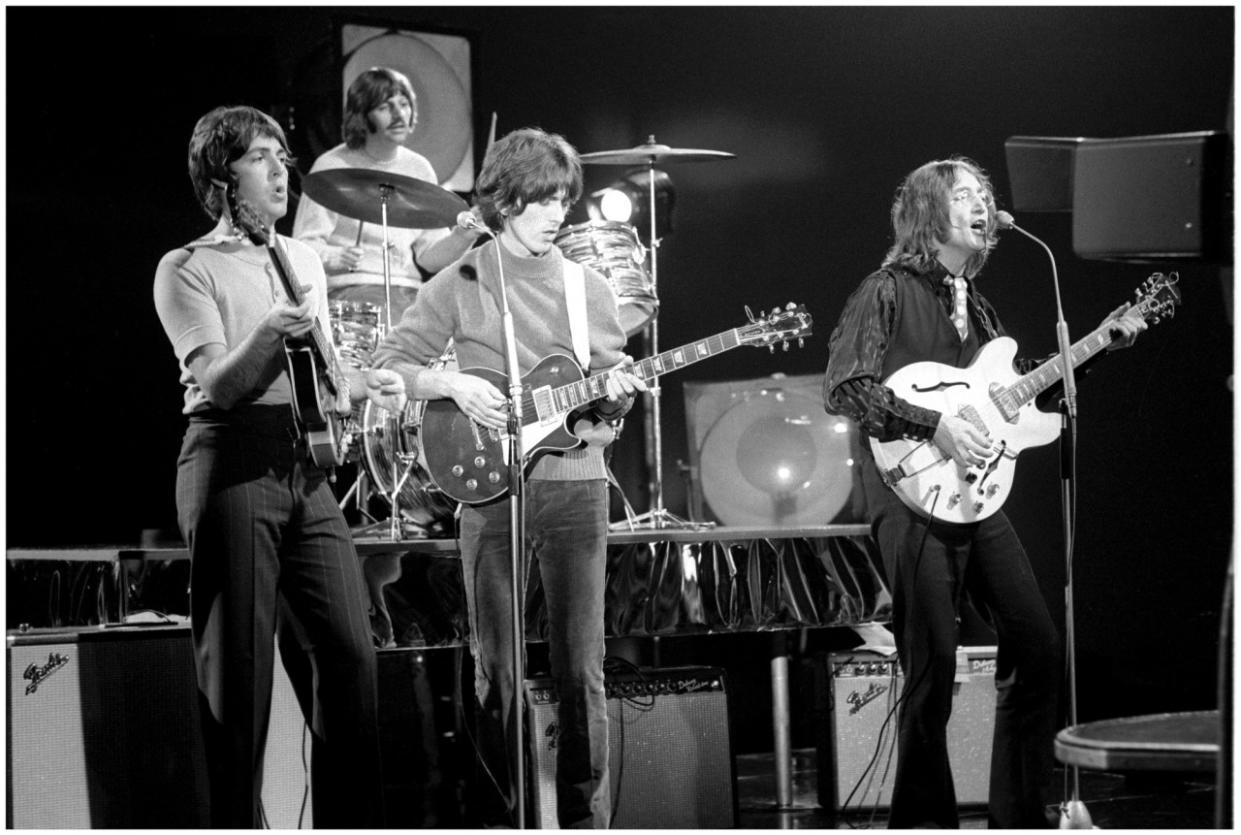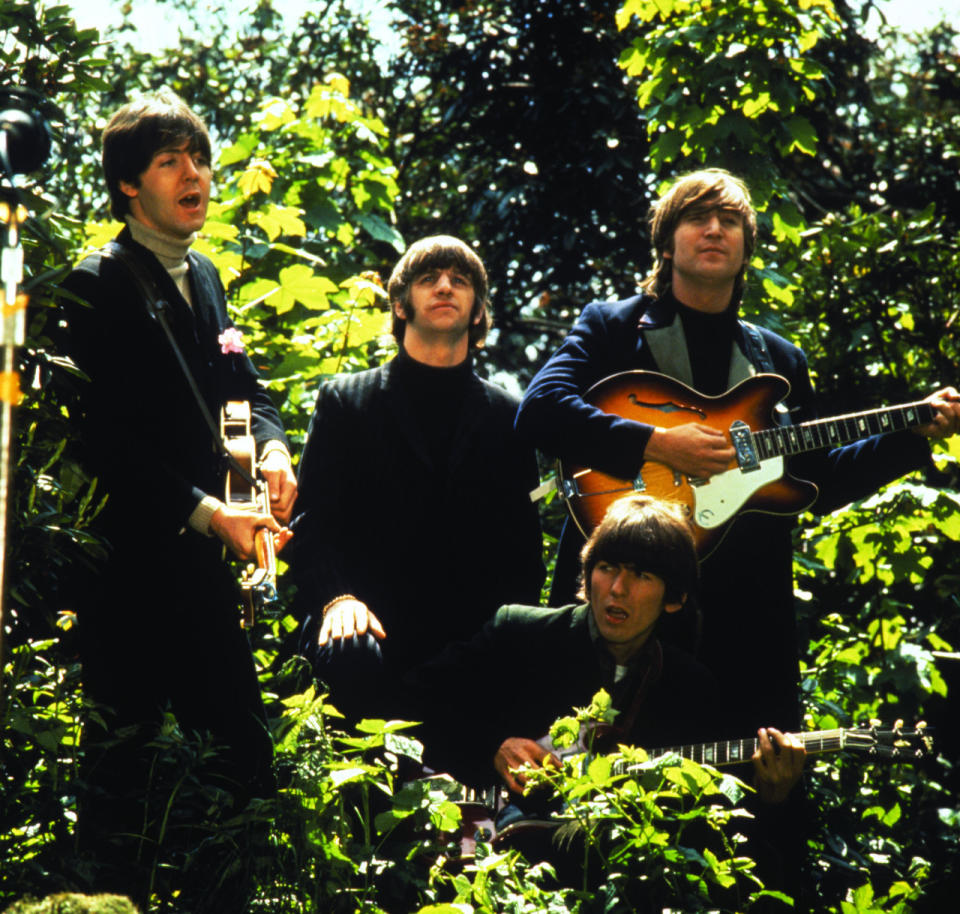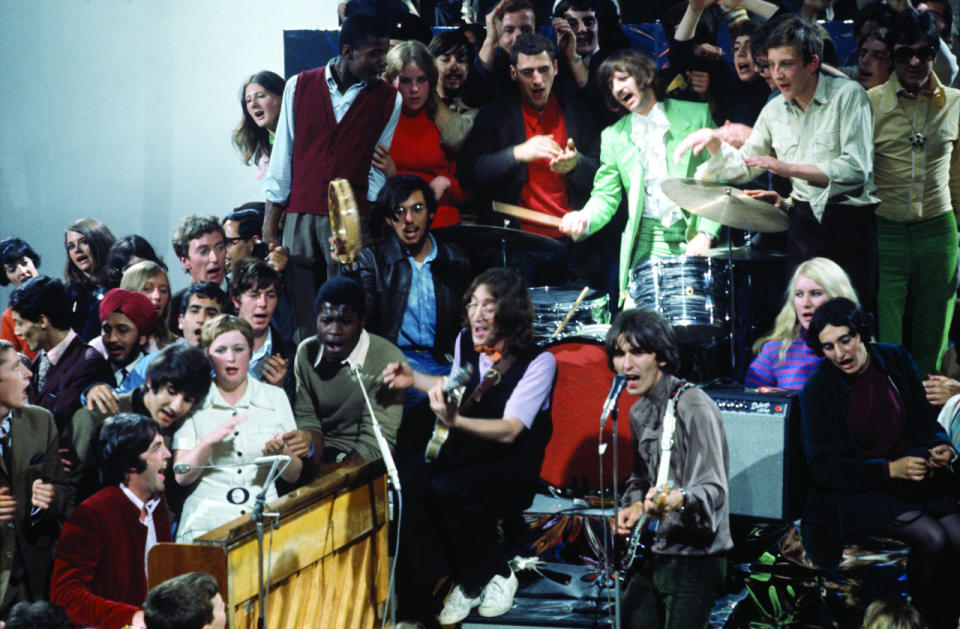Looking Back at the Beatles '1' Promo Clips With Director Michael Lindsay-Hogg

When Michael Lindsay-Hogg first got the call, he admits he was “truly shocked and frightened.” Then 25 years old, he was a director working on the groundbreaking live music program Ready, Steady, Go! with such acts as the Rolling Stones, the Who, and the Yardbirds – but when he got the call from Brian Epstein’s office to work with the Beatles, he was taken aback.
“The Beatles were like the Concord airplane,” Lindsay-Hogg says. “They were just flying higher than anyone at the time.” Yet, despite that initial trepidation, Lindsay-Hogg took the gig and went on to work with the Fab Four from 1966 through 1970, directing promo clips for some of their best-known songs, as well as the film Let It Be.
Five of those videos are featured on the Beatles 1, the new 27-track CD/DVD and CD/Blu-ray package released by Apple Corps. on Nov. 6 that features restored versions of the promo clips for the band’s chart-topping singles. The deluxe edition, 1+, adds a 23-track second disc with seven promo clips lensed by Lindsay-Hogg.
By the time Lindsay-Hogg began to work with the Beatles, they were already the biggest pop group in the world. They had survived Beatlemania, the scandal surrounding John Lennon’s infamous “bigger than Jesus” comment, and had given up touring after their 1966 U.S. trek in favor of focusing on their work in the studio.
Meet the Beatles
“They were great,” Lindsay-Hogg says. “They were used to performing, and also because they had done A Hard Day’s Night and Help!, they were used to the cameras. They were used to everything. They were used to enormous celebrity. Nothing fazed them much.”
At the time, the concept of filming a visual accompaniment for a song was still relatively new. “Videos at that time, or as we called them promo films, had no history,” says Lindsay-Hogg. “There really weren’t any. The Beatles had done a few around the time of Help!, but there were not a lot of them.”
“Paperback Writer” / “Rain”
For "Paperback Writer,” the band’s first collaboration with Lindsay-Hogg in April of 1966, the director had initially conceived a story concept. “The idea was that they’d be working in a newspaper office with old typewriters and things like that and Paul would be playing someone, who on the side, was writing a paperback novel. Not an incredibly original idea,” Lindsay-Hogg admits, “but it would have given us something to look at and different visuals than what we were used to seeing when they performed on television or on film.”

(Photo: Courtesy Apple Corps Ltd.)
However, Epstein nixed the concept. “I think that since they hadn’t appeared on TV for a while performing, that it would be more useful for them, i.e. probably sell more records, if it was just them performing, as opposed to doing anything kooky.” So Lindsay-Hogg filmed them miming along to the track, and its B-side “Rain,” at Abbey Road Studios and then the following day on the scenic grounds of the Chiswick House, an 18th century mansion, in West London. McCartney looks a little different in the “Paperback Writer” clips. He chipped a front tooth in a motorized bicycle accident prior to the filming.
In general, Lindsay-Hogg found the Beatles to be a tight-knit group. “They were very insular,” he recalls. “It was the four of them and everybody else was kept at a distance, except for Brian and the four or five other people who had come down from Liverpool with them originally.”
As Lindsay-Hogg explains, it was almost as if the band was in a cage, albeit “a very nice cage. When I gave them this idea for the first time for the video, it was kind of like making an offering to the cage. They’d pick it up and smell it and toss it around and take a bite of it, and if it tasted right, pass it on to the other, so when it finally came back to me, it was in a slightly different shape than it was when I offered it to them. They were used to dealing with each other. The ideas would bat from one to the other to the other and then the rest of the world could be included. They were very close at that time, probably as close as they ever were.”
Those first few clips were shot and edited quickly, with “Paperback Writer” turning up on the BBC’s Top of the Pops three days later.
“Hey Jude” and “Revolution”
In September 1968, Lindsay-Hogg again hooked up with the band to direct the promo film for “Hey Jude,” which had already been released as a single in the U.S. the week prior, for airing on Frost On Sunday. Before host David Frost introduces the band, they serenade him with a loose version of his theme song. And after the intro, they dip into a snippet of a jokey rough-and-tumble version of the Elvis Presley hit, “It’s Now or Never.”
What’s unique about this clip, as well as some of the other latter period videos included on 1 and 1+, is that the audio differs from the recordings on the Beatles singles and albums. As Paul McCartney notes in the bonus commentary on 1, the band used a backing track, but his vocals were live in an attempt to get around the Musicians’ Union rules that prohibited acts from miming to backing tracks. The same is true of “Revolution,” which features John Lennon singing live to a backing track while the backing vocals by McCartney and George Harrison are a combination of pre-recorded tracks and live singing.
The concept of the “Hey Jude” clip is also interesting. It begins with tight shots of the band performing the song. “There are lots of lovely close-ups of these fab boys who are very good-looking 20-somethings,” McCartney notes, while ad-libbing during the DVD commentary. “It’s great for me looking at this, just seeing our departed buddies and feeling the love.”
However, the length of the song and its extended closing chorus provided a challenge for Lindsay-Hogg. “The problem with the song is visually what would we shoot for that four-minute chorus?” he says. “So Paul and I thought maybe what we should is get in a group of people, not just the normal kids from the fan club, but a cross section of people, different ages, different colors, different professions,” he explains. “So they would be singing the chorus and helping to provide the visuals as well as the Beatles, and it worked better than we ever could have imagined because the interaction between the Beatles and the crowd was terrific.”

(Photo: Courtesy Apple Corps Ltd.)
“The Beatles had stopped touring in ‘66 and they really hadn’t been near any crowd,” he adds. “They kind of loved it again and that’s what led us into what became [the film] Let It Be, because they kind of liked playing again and thought they could do it once more.”
Let It Be and the Rooftop Concert
The final group of clips were all shot for inclusion in what became to be known as the film Let It Be. “It was originally going to be a television special for CBS,” Lindsay-Hogg recalls, “but they never could agree where it would take place or what the style should be. George didn’t really want to do it all.”
The idea of the TV special was scrapped, but they did keep a few cameras around documenting the band rehearsing. “That was very interesting because no one really had cameras at the Beatles rehearsing before, but [the project] didn’t have any aim to it.”
In order to give the project some focus, Lindsay-Hogg suggested a live performance on the roof of the Apple building in London. “It wasn’t a definite go until about 20 minutes before when they all agreed they’d do it,” he recalls. There were also other factors to consider, including the weather. “We were going to do it the day before, on a Thursday, but the clouds were too low, the sky was too dull and it was too gray, so we pushed to Friday,” Lindsay-Hogg recalls. “On Thursday we had 11 cameras ready to go, and we had them again on Friday. Once we decided to pretty much do it, we were going to wait for good sky.”
During that time, tensions within the band had also risen to a breaking point, as Lindsay-Hogg remembers “they were being slightly crappy with each other when they were working.” Then again, he says that such creative tensions often arise. “That’s not uncommon,” he adds. “With every art form, whether it’s theater, ballet, or music, people don’t always see eye to eye at the same time, so you can sometimes feel friction and tension.”
However, that tension melted away once the band strapped on their instruments and plugged in for what turned out to be the band’s final live performance, on the roof of the Apple building. “First of all, it was very cold, so everyone kind of bonded over how cold it was,” Lindsay-Hogg says. “But then, they played for 25 or 30 minutes and they really loved it. It was probably just like it was when they played in Hamburg 10 years before. They just really connected with each other, and also the idea of the audience down below, so the roof was a very happy occasion.” The rooftop performance of “Get Back” is featured on 1, while 1+ adds the rooftop take of “Don’t Let Me Down.”
The film Let It Be, which includes the rooftop live performances and studio sessions of the title track and “The Long and Winding Road,” was originally released theatrically in 1970, but up to this point, has not been officially released on DVD. “I think what happened over the years, when they broke up, it represented to them – one or two of them anyway – that it was a time when they probably weren’t getting along and you can smell the breakup happening in the air,” Lindsay-Hogg says. “They had to deal with, over time, what Let It Be meant to them.”
While the film has its dark points, Lindsay-Hogg also says “it’s a fascinating document about them rehearsing, about the interaction between them and also what they looked like close-up, when they were 28 or 27 or 26, and then of course with history we know what happened a couple of them – George died way too young, John was murdered – so it has a kind of poignancy now as well as being an extraordinary document of how they were and how they acted together.”
As for an official DVD and Blu-ray release of Let It Be, Lindsay-Hogg says the final word will come from Apple Corps. in London, but he adds, “I can envision that some time in the next year or so, they might re-release it. We’ve all seen it fairly recently. It looks great. The images have been buffed up, the sound has been given the same attention as the sound on Beatles 1.”
Until then, Beatlemaniacs will make do with the clips from the film, including the studio takes of the title track and “The Long and Winding Road,” and the rest of the material on Beatles 1. “The whole package is amazing,” Lindsay-Hogg says. “I think they’ve done a fabulous job at polishing up the images and making the sound as good as possible. I’m not trying to hustle the package, but it really is a good one.”

